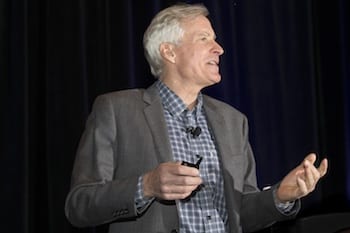Who is a member?
Our members are the local governments of Massachusetts and their elected and appointed leadership.

David Breashears speaks to crowd of local officials at the opening session of Annual Meeting
In a harrowing and inspiring tale of loss and selflessness during a tragic event on Mount Everest, mountaineer and filmmaker David Breashears imparted the importance of trust, shared values and humility in building and leading a successful team.
In his keynote address to 1,000 local officials during the MMA’s Annual Meeting on Jan. 19, Breashears described his experiences on the world’s highest peak in May 1996.
Shedding weight was so critical that his team cut their toothbrushes in half, but the hardest part wasn’t hauling a heavy IMAX camera to 29,000 feet – it was having the humility to turn around when the situation called for it, and for his team to put aside its goals in order to help others during what was at the time the deadliest single day in the mountain’s recorded history.
When it comes to building an effective team, he said, “Trust is the glue.” And trust is more easily established if team members share the values of selflessness, kindness and generosity. These values, he said, must be immutable, or trust can’t be built.
“Selfish just doesn’t work in the mountains, it doesn’t work in relationships, it doesn’t work on teams,” he said.
Competence and talent are necessary components when building a team, Breashears said, but those traits are relatively easy to find, while trust and selflessness are harder. Leaders need to set an example with these traits, including in critical situations.
“If I don’t get out on that rope and trust people to hold that rope, so that I don’t swing against either side of that gorge and splat like a fly, then it’s not going to work,” he said. “They saw me out there and I saw them, doing their work. Those bonds were formed before we got high on the mountain, when things were going to go quite wrong, and we really needed to trust each other.”
He lamented the erosion of dignity in our culture today and the rise of a me-first, winner-take-all attitude. Whether he was being led up the mountain or was leading a team himself, he wanted to work with people who cared as much for him as they cared for their own advancement.
“I’m not getting rich climbing mountains – I never will, but I love it,” he said. “And I don’t think any of you are getting rich in your work, and that’s why I really like this room full of dedicated public servants. You do the work because it’s meaningful and you care about it.”
When climbing Everest, he said, it’s critical to not make decisions that would put anyone else at risk.
“In your world, don’t move up too quickly,” he said. “You put other people at risk in terms of how the whole team performs.”
Breashears described how, in the spring of 1996, at 24,000 feet and facing winds of up to 70 miles per hour, his highly skilled team made the difficult decision that it wasn’t the right time for them to mount an ascent. Guided teams with far less experience, however, continued up the mountain while Breashears’ team descended.
“They had ambition,” he said. “Ambition’s easy. Anyone can be ambitious.”
Breshears’ team found themselves helping others – some injured, some already dead – to get back to base camp during a blizzard. Meanwhile, they were hearing reports of others stranded on the mountain, including experienced guides like Scott Fisher.
“When we’re so much into something that we don’t know when to stop, even though it’s falling apart … that’s hard to do,” Breashears said.
After the storm had passed and back at camp, Breashears admitted he “did the wrong” thing by demanding, instead of asking, that his team go back up toward the summit. He put his desires first and, in doing so, had harmed the team dynamic.
“I had to give them back their agency and befriend them again after I alienated them,” he said. “I showed that I cared about them, and not just about the film.”
After 13 days of putting the IMAX camera aside, the team picked it up again, and began its eventual ascent to the summit. While they had another purpose during those 13 days of helping others, the camera again provided the team with that common bond.
“Without that camera, we weren’t a team,” Breshears said. “Without an idea that you present to your team – the idea of excellence, a sense of purpose, a goal, or an ideal – you’re not a team. Teams operate around something big, an organizing principle.”